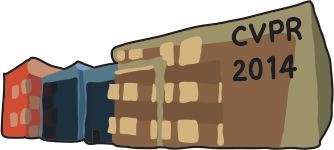-
Detecting Objects using Deformation Dictionaries
AbstractSeveral popular and effective object detectors separately model intra-class variations arising from deformations and appearance changes. This reduces model complexity while enabling the detection of objects across changes in view- point, object pose, etc. The Deformable Part Model (DPM) is perhaps the most successful such model to date. A common assumption is that the exponential number of templates enabled by a DPM is critical to its success. In this paper, we show the counter-intuitive result that it is possible to achieve similar accuracy using a small dictionary of deformations. Each component in our model is represented by a single HOG template and a dictionary of flow fields that determine the deformations the template may undergo. While the number of candidate deformations is dramatically fewer than that for a DPM, the deformed templates tend to be plausible and interpretable. In addition, we discover that the set of deformation bases is actually transferable across object categories and that learning shared bases across similar categories can boost accuracy.
Related Material
[pdf][bibtex]@InProceedings{Hariharan_2014_CVPR,
author = {Hariharan, Bharath and Zitnick, C. L. and Dollar, Piotr},
title = {Detecting Objects using Deformation Dictionaries},
booktitle = {Proceedings of the IEEE Conference on Computer Vision and Pattern Recognition (CVPR)},
month = {June},
year = {2014}
}
These CVPR 2014 papers are the Open Access versions, provided by the Computer Vision Foundation.
Except for the watermark, they are identical to the accepted versions; the final published version of the proceedings is available on IEEE Xplore.
Except for the watermark, they are identical to the accepted versions; the final published version of the proceedings is available on IEEE Xplore.
This material is presented to ensure timely dissemination of scholarly and technical work.
Copyright and all rights therein are retained by authors or by other copyright holders.
All persons copying this information are expected to adhere to the terms and constraints invoked by each author's copyright.

